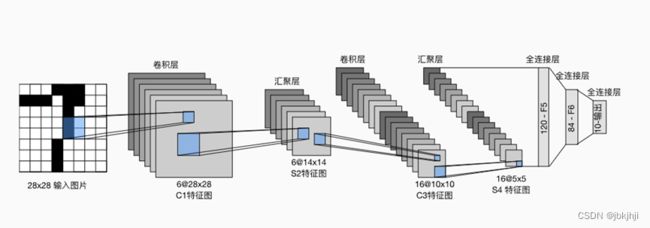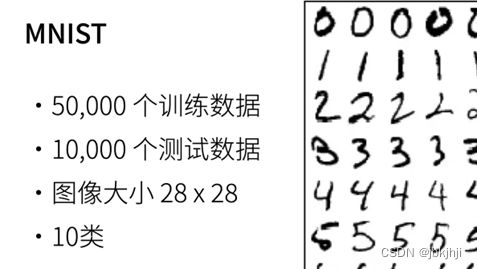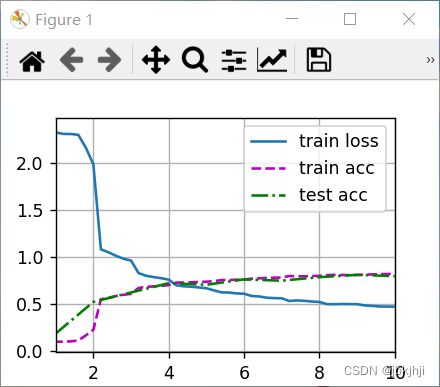深度学习——LeNet的实现(笔记)
1.LeNet是用来分辨手写体的数字的,分辨出来是哪个数字的可能性。
用到的数据集是MNIST
先用卷积层来学习图片的空间信息,用池化层降低图片的敏感度。最后用全连接层转换为类别的空间,转换为10类。
【总结】
①LeNet是早期成功的神经网络
②先使用卷积层来学习图片空间信息
③然后使用全连接层来转换到类别空间
【代码实现:】
1.构建神经网络,加入激活函数是为了非线性
import torch
from torch import nn
from d2l import torch as d2l
# 构建神经网络 加入激活函数是为了非线性
net = nn.Sequential(
nn.Conv2d(1, 6, kernel_size=5, padding=2), nn.Sigmoid(),
nn.AvgPool2d(kernel_size=2, stride=2),
nn.Conv2d(6, 16, kernel_size=5), nn.Sigmoid(),
nn.AvgPool2d(kernel_size=2, stride=2),
nn.Flatten(),
nn.Linear(16 * 5 * 5, 120), nn.Sigmoid(),
nn.Linear(120, 84), nn.Sigmoid(),
nn.Linear(84, 10)
)2.验证网络
测试验证
X = torch.rand(size=(1, 1, 28, 28),dtype=torch.float32)
for layer in net: # nn.Sequential() 所以每一层做出一次迭代 拿出来
X = layer(X)
print(layer.__class__.__name__,X.shape)3.获取数据集
# LeNet在Fashion-MNIST数据集上的表现
batch_size = 256
train_iter, test_iter = d2l.load_data_fashion_mnist(batch_size=batch_size)4.使用GPU计算模型在数据集上的精度
# 使用GPU计算模型在数据集上的精度
def evaluate_accuracy_gpu(net, data_iter, device=None): # @save
"""使用GPU计算模型在数据集上的精度"""
if isinstance(net, nn.Module):
net.eval() # 设置为评估模式
if not device: # device=None
device = next(iter(net.parameters())).device
# 正确预测的数量,总预测的数量
metric = d2l.Accumulator(2)
with torch.no_grad():
for X, y in data_iter:
if isinstance(X, list):
# BERT微调所需的(之后将介绍)
X = [x.to(device) for x in X]
else:
X = X.to(device)
y = y.to(device)
metric.add(d2l.accuracy(net(X), y), y.numel())
return metric[0] / metric[1] # 分类正确的个数/整个y的大小5.开始训练
def train_ch6(net, train_iter, test_iter, num_epochs, lr, device):
"""用GPU训练模型(在第六章定义)"""
def init_weights(m): # 初始化weight
if type(m) == nn.Linear or type(m) == nn.Conv2d: # 如果是全连接层或者卷积层
nn.init.xavier_uniform_(m.weight) # xavier根据输入输出的大小,输入输出的方差差不多。模型变得稳定。
net.apply(init_weights) # 使网络的每一层的weight都 xavier
print('training on', device)
net.to(device) # 模型选择GPU,没有GPU就是CPU
optimizer = torch.optim.SGD(net.parameters(), lr=lr) # 定义优化器SGD
loss = nn.CrossEntropyLoss() # 定义交叉熵损失函数
animator = d2l.Animator(xlabel='epoch', xlim=[1, num_epochs],
legend=['train loss', 'train acc', 'test acc']) # 画图用的。
timer, num_batches = d2l.Timer(), len(train_iter)
for epoch in range(num_epochs):
# 训练损失之和,训练准确率之和,样本数
metric = d2l.Accumulator(3)
net.train()
for i, (X, y) in enumerate(train_iter):
timer.start()
optimizer.zero_grad() # 梯度清零
X, y = X.to(device), y.to(device) # 参数用GPU
y_hat = net(X)
l = loss(y_hat, y) # 计算损失函数
l.backward() # 反向传播
optimizer.step() # 优化器调优
with torch.no_grad(): # 以下代码是 为了画图
metric.add(l * X.shape[0], d2l.accuracy(y_hat, y), X.shape[0])
timer.stop()
train_l = metric[0] / metric[2]
train_acc = metric[1] / metric[2]
if (i + 1) % (num_batches // 5) == 0 or i == num_batches - 1:
animator.add(epoch + (i + 1) / num_batches,
(train_l, train_acc, None))
test_acc = evaluate_accuracy_gpu(net, test_iter)
animator.add(epoch + 1, (None, None, test_acc))
print(f'loss {train_l:.3f}, train acc {train_acc:.3f}, '
f'test acc {test_acc:.3f}')
print(f'{metric[2] * num_epochs / timer.sum():.1f} examples/sec '
f'on {str(device)}')
d2l.plt.show()6.训练和评估模型
lr, num_epochs = 0.9, 10
train_ch6(net, train_iter, test_iter, num_epochs, lr, d2l.try_gpu())最后的结果
loss 0.474, train acc 0.820, test acc 0.797
36176.0 examples/sec on cuda:0



